New technology has brought a wealth of minimally invasive procedures to fight the signs of ageing. But what’s the most effective method you should choose?
As we age, our skin begins to lose its elasticity and youthful glow, which can leave you looking older than your inner self. Wrinkles are a natural part of getting older, and there’s no reason to dread getting them. Yet, while you should always embrace and love your skin and body at any age, there’s no need to feel bad about wanting to hold on to a few youthful perks. After all, there is no vanity in wanting to look more attractive. So if you would like to slow the signs of ageing on your face, we have good news for you. There are safe and cost-effective alternatives that aren’t just about surgical procedures or skin care. By playing your cards right and carefully choosing the treatment, you can effectively manage signs of ageing in a non-invasive way.
Choice of facial rejuvenation method

Modern technology gives us a wide range of treatments available for facial tightening and rejuvenation. Being given so many options sometimes makes it difficult to decide which treatment is right for you. If you’ve done some research on the topic, surely you’ve come across terms such as high-intensity focused ultrasound (HIFU) and radiofrequency (RF).
RF and HIFU became buzzwords that are often thrown around when talking about anti-ageing. But do you know how is RF different from HIFU and how exactly they can help to restore the look of youthful skin?
Essentially, both, HIFU and RF are non-surgical, non-invasive skin tightening treatments that heat up the skin to induce a collagen remodelling response in its deep layers. Although they both do reduce the appearance of wrinkles they use different technologies to do so. Thus, in some cases, one method may be more suitable than the other.
To help you make a more informed decision when choosing between HIFU and RF treatment we bring you some facts about each method to later compare them and give you more specific recommendations.
But before we discuss how to choose between RF and HIFU, it is important to understand the physiology of skin to know what happens to it as we age.
How the face ages
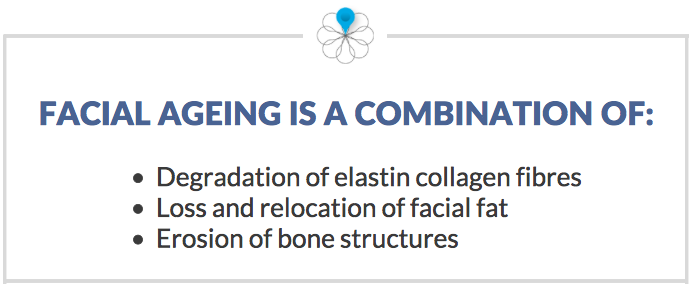 While most people think of wrinkles as the primary manifestation of facial ageing, the reality is far more complex. The ageing process affects the entire facial structure, including skin, subcutaneous fat, muscles and facial bones.
While most people think of wrinkles as the primary manifestation of facial ageing, the reality is far more complex. The ageing process affects the entire facial structure, including skin, subcutaneous fat, muscles and facial bones.
Understanding the ageing process and knowing how each face component (skin, fat, bones) changes over time will enable you to decide what combination of treatments is best to achieve optimum results. So first, let’s get to the bottom of what is happening to our faces as we age.
Facial structures affected by ageing
Signs of ageing are cumulative effects the fat relocation, changes in bone tissue, and breakdown of collagen and elastin fibres.
 Our faces change primarily due to the modification of soft tissue and fat component. The number of collagen fibres decreases and the remaining ones become disorganized. As the tissue weakens, it stretches, becomes more prone to wrinkling, sagging, and fine lines are deepening.
Our faces change primarily due to the modification of soft tissue and fat component. The number of collagen fibres decreases and the remaining ones become disorganized. As the tissue weakens, it stretches, becomes more prone to wrinkling, sagging, and fine lines are deepening.
Due to chronic exposure to gravity facial fat descends to the lower portion of the face. In result, skin loses its support and hollows causing the face to appear sunken. The skin and fat that migrates downwards herniates below the jawline and behind the chin strengthening the sagging effect.
But the ageing processes do not stop on the skin and its fat layer. Even though it may seem that the bony component of the face remains relatively stable it also changes over time. The bone structure does not rebuild itself. Thus, with time, we can see an overall and gradual reduction in mass, that causes differences in the shape of the face. This loss of support makes cheekbones and nose to appear more prominent. And when combined with the effects of ongoing hollowing and sagging, it enhances the visibility of the fine lines and wrinkles.
Because the majority of the non-surgical facial rejuvenation methods do not work beneath the skin tissues let’s take a closer look at the skin and the ageing process taking place in skins layers.
Layers of the skin
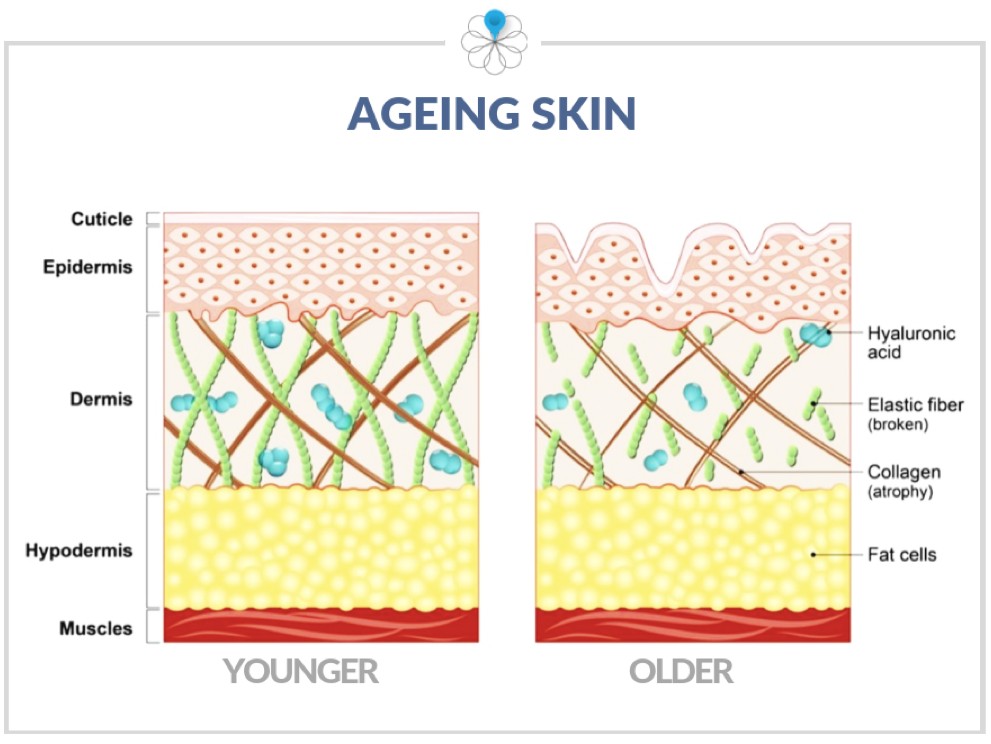 The skin is made up of three layers: the outer layer (epidermis), the middle layer (dermis), and the deepest layer (hypodermis). Although skin cellular renewal takes place within the deeper layers (with new skin cells moving outward towards the epidermis) each layer of the skin serves an important function.
The skin is made up of three layers: the outer layer (epidermis), the middle layer (dermis), and the deepest layer (hypodermis). Although skin cellular renewal takes place within the deeper layers (with new skin cells moving outward towards the epidermis) each layer of the skin serves an important function.
The outer layer contains pigments that are our natural protection against sun-induced skin damage. The dermis contains collagen and elastin – two proteins necessary for skin health and that supply energy and nutrition to the epidermis. The hypodermis accommodating the protective layer of fat and the sweat glands has insulation and moisturising functions.
Each layer also contains connective tissue with collagen fibres that provide the support necessary for the flexibility and strength of the skin. But what is the collagen you may ask? This mesh-like component makes up 75% of your skin and lives in the lower levels of the dermis. You can think of collagen as the framework or structure that provides strength and foundation for the rest of your skin. After you smile or frown (with help from elastin), your skin returns to its original structure, thanks to collagen. *
Age-dependent changes in skin layers
With age, the outer skin layer (epidermis) thins and starts to appear paler and translucent. In effect, causing pigmented spots to appear in sun-exposed areas. Moreover, between our thirties and eighties, the epidermal turnover rate of our cells slows for about 30-50%. This slowdown of cell turnover accounts for the characteristic dull, rough skin surface seen in maturing skin. Consequently, it becomes more fragile so that frequent rubbing and pulling can easily cause skin tears.
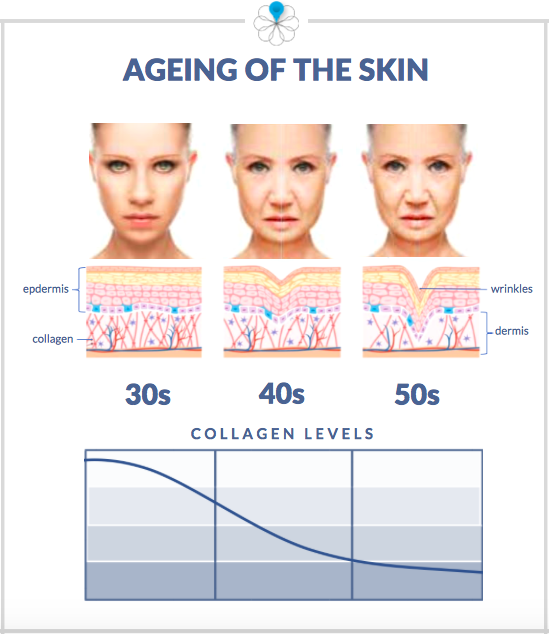 The majority of age-dependent changes that occur in our skin happen in its middle layer. Due to ageing and environmental factors, collagen and elastin diminish over time. And lack of them causes the skin to wrinkle and sag. Gradual decrease of collagen and elastin that are produced at a slower rate impacts the skin’s ability to repair. In effect, dermis loses 20-80% of its thickness during the ageing process. This, in turn, prolongs the time the skin takes to assume its original position when extended or pulled. The decrease in collagen and elastin proteins along with a comprised barrier layer in the epidermis is likely to cause dehydration and loss of turgidity. Resulting in further drooping of the face and loss of elasticity.
The majority of age-dependent changes that occur in our skin happen in its middle layer. Due to ageing and environmental factors, collagen and elastin diminish over time. And lack of them causes the skin to wrinkle and sag. Gradual decrease of collagen and elastin that are produced at a slower rate impacts the skin’s ability to repair. In effect, dermis loses 20-80% of its thickness during the ageing process. This, in turn, prolongs the time the skin takes to assume its original position when extended or pulled. The decrease in collagen and elastin proteins along with a comprised barrier layer in the epidermis is likely to cause dehydration and loss of turgidity. Resulting in further drooping of the face and loss of elasticity.
As we age, we lose some of the fat beneath the superficial skin layers. In result, the hypodermis also begins to thin contributing to a loss of structure that holds up the skin. This can cause blood vessels just below the surface to look more prominent and your skin to look discoloured. Moreover, sebaceous glands located in the hypodermis produce less oil as you age (beginning after menopause) making it harder to keep the skin moisturised. This increases the issue of dryness and itchiness, raising the risk of skin injury.
Now that we understand a little bit better the changes happening in each skin layer let’s take a closer look at their effects that we start to see as we age.
Different signs of ageing
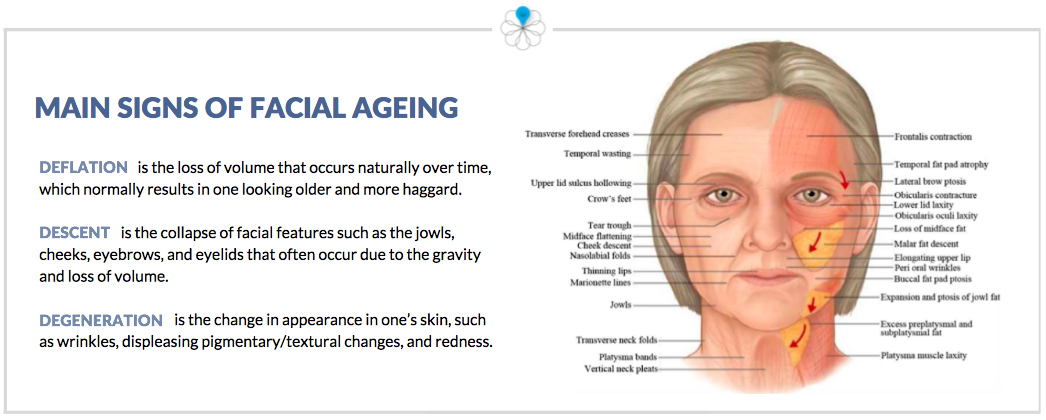 As we grow older we suffer the 3 main signs of ageing: descent, deflation, and degeneration.
As we grow older we suffer the 3 main signs of ageing: descent, deflation, and degeneration.
Sagging:
Facial descent is best referred to as sagging skin. Lax tissue and loose skin are most noticeable in the appearance of sunken or hollow cheeks, and hanging skin in the form of jowls under the neck, creating a drooping appearance under the eyes and along the jawline. As a result of tissue degeneration as well as collagen and elastin loss, skin sags and forms lines and wrinkles, collecting in the lower down on the face.*
Volume loss:
Deflation refers to volume loss in the face, usually in the form of subcutaneous fat deposits losing their support and appearing sunken. Over time the fatty tissue, collagen and elastin start to trail off. This leaves our face more brittle, less firm, and more prone to remodelling and creates a hollow appearance. *
Wrinkling:
Degeneration refers to a process of our skin losing its tone and texture (age spots, hyperpigmentation, and static wrinkles). It’s caused by lower levels of collagen and elastin—the building blocks of firm, strong skin.* Lacking these two elements, dead cells tend to build up—causing a dull, tired look—and the skin becomes more weathered, fragile, and sensitive to external factors. Extrinsic factors such as diet, sun or pollution exposure can also increase the skin regeneration process.
HIFU skin tightening
Devices used for RF skin tightening: Ulthera®, Doublo®
It’s a new type of non-surgical, non-invasive method that uses ultrasound technology and the body’s own natural healing process to tighten and tone wobbly skin on your face.
Different from the gentle king of ultrasound energy that doctors use for imaging babies in the womb, HIFU treatment uses high-intensity focused ultrasound waves. Their high concentration enables the technology to get to a specific point below the surface of the skin where it reaches the SMAS layer (muscle layer). Working deep below the surface it stimulates the growth of collagen without harming the outer layer of skin. This results in long-lasting firming, and tightening of the skin, after just one treatment.
How does HIFU skin tightening work
The device releases highly concentrated ultrasonic energy that is delivered deep into the skin causing very precise thermal coagulation that reaches the SMAS layer. Delivering tiny deposits of focused ultrasound energy it precisely heats up a specific location in a short period of time. Your skin responds to this energy by stimulating its deep dermal tissue to produce new compact collagen fibres. This, in turn, leads to a gradual tightening and improvement of your skin elasticity and firmness. As the skin tightens, wrinkles and lines become less visible. The texture of the skin is improved as it becomes smooth, shiny and firm.
Expected results of HIFU skin tightening
Initial tightening of the skin can be seen immediately after treatment, and it continues gradually over time. This means that with just one treatment, the regenerative process is initiated but its full results will unfold over the course of 2-3 months.
Radiofrequency skin tightening (RF)
Devices used for RF skin tightening: Pellevé®, THERMI RF®, Exilis®, and Thermage®
RF skin tightening relies on devices that use radiofrequency waves to convert energy from radio to heat. Energy produced this way heats the skin’s deeper layers to stimulate collagen remodelling response. The radiofrequency used in those devices is different from that emitted by your microwave or cell phone, or radar equipment. Its low frequency is closely monitored to ensure that targeted tissues reach the optimal temperature to induce new collagen production and cell regeneration without overheating. This way it can safely penetrate to a deeper level of the skin helping to improve its tone and structure.
How does RF skin tightening work
Radiofrequency is a laser that treats the dermis, the middle layer of the skin, with concentrated heat. It penetrates no further than 3mm deep into skin tissues selectively heating it to promote two types of responses. However, the deeper the penetration, the less impact of the heat, and so this treatment has its limits. The waves emitted carry heat and energy deep into the skin, which has a positive effect on the lymphatic and vascular systems by increasing the fluid flow through the cells. Heating in this area, without damaging the outer layers of the skin, causes microscopic changes to the tissues and collagen contraction. This stimulates subsequent collagen production over the ensuing months and results in the immediate tightening of skin tissues. By improving deep blood circulation it also gives your skin a natural glow and enhances the skin’s luminosity.
Expected results RF skin tightening
RF can be used with any skin complexion and is ideal for facial rejuvenation, reshaping and resituating the facial musculature, raising the eyebrows and clearing the area around the eyes, improving wrinkles and fine lines. It’s primarily used to treat skin laxity by facial tightening, and it is best suited to clients with mild to moderate sagging of facial tissues, usually those in their mid-thirties to fifties.
Collagen stimulation starts during the treatment and continues for many months afterwards. For best results, you might need several sessions over the first few months and one or two sessions per year for the purpose of maintenance. But the recommended frequency of sessions depends on the specific device used for the treatment.
RF vs HIFU
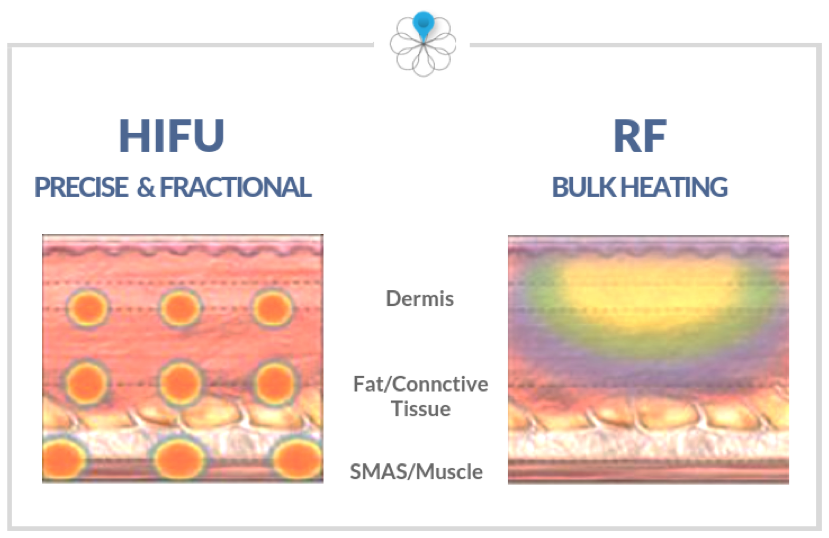 Although they serve the same intention, these two methods are quite different and using one or the other will depend hugely on the results that you want to achieve. We’ve listed the main differentiating points to clarify the process and help you chose the treatment that fits your needs best.
Although they serve the same intention, these two methods are quite different and using one or the other will depend hugely on the results that you want to achieve. We’ve listed the main differentiating points to clarify the process and help you chose the treatment that fits your needs best.
Main differences
The first and most obvious way in which they differ is that they use different technologies to heat up the deep skin tissues. HIFU delivers more precise and more intense fractional ultrasound energy while RF is based on a bulk heating strategy.
Second, each technology works in different, but partially overlapping skin layers. HIFU goes much deeper into and beyond the dermis, being able to reach the SMAS layer. RF, on the other hand, will not go as deep as HIFU. It focuses on epidermal layers and does not go beyond the deep dermis.
Third, while HIFU is generally performed as a single treatment RF may require several sessions. The exact frequency of either of those treatments will depend on the type of device used and your skin conditions such as its current elasticity or your genetic heritage.
Fourth, using ultrasound energy in cosmetic procedures is a relatively new practice. So in terms of aesthetic facial rejuvenation, RF has been around much longer.
How to choose between HIFU and RF
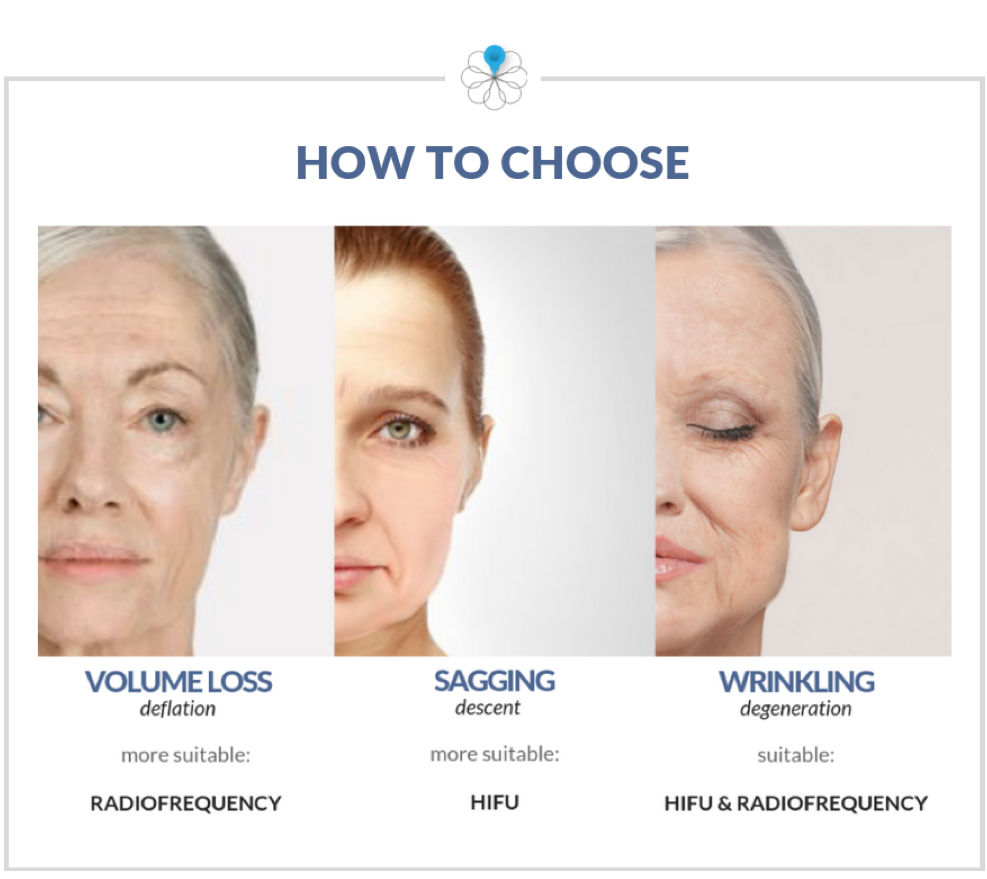 As we age our face starts to exhibit a mix of sagging, wrinkling and sinking. Although each person’s ageing style is always unique and should always be addressed individually the following guide explains how different treatments may be more suitable for different types of issues.
As we age our face starts to exhibit a mix of sagging, wrinkling and sinking. Although each person’s ageing style is always unique and should always be addressed individually the following guide explains how different treatments may be more suitable for different types of issues.
If your main problem is sagging and your ultimate goal is “lifting” effect it might be a better idea for you to go for HIFU. The depth of its tissue tightening will allow for more prominent results. Thus, HIFU will be the best choice for tightening loose skin around the jowls, improve the appearance of a double chin or “lifting” the brows.
RF being a less intensive method that penetrates tissues not as deep as HIFU can be a better choice for addressing volume loss or treating delicate areas such as lower and upper eyelids. Thus, if you have no or limited skin laxity, but are losing facial volume you may opt for the RF. It will tighten the skin but also create the effect of more volume especially in the area around the mouth.
Both HIFU and RF boost collagen production and accelerate skin tissues remodelling. Thus, they’re both effective in treating wrinkles and fine lines. The best method for treating the signs of skin degeneration will thus depend on the extent of your skin ageing and the area you want to treat. For this reason, deciding on any treatment type you should always consult a specialist who can professionally asses your facial anatomy and your skin laxity. And only after the physical examination, a specific treatment recommendation can be made.
Where to get HIFU and RF treatment
As with any aesthetic procedure, the results of either HIFU or RF are based upon the skill and experience of the person performing the treatment. Thus, to ensure the safety and efficacy of the treatment you should carefully choose the salon you get it at.
To make the process of finding the best salon a bit easier for you we got you a list of Hong Kong’s salons whom unparalleled reputation guarantees that you’ll be in good hands.
Radiofrequency: in Causeway Bay: Majomi Skin Centre, Iconic Beauty, in Central: Skin Renew, L’Organic Beauty, in Tsim Sha Tsui: Dazzllab, Soul Pure Beauty.
HIFU: in Central: EstheClinic, L’Organic Beauty, in Causeway Bay: Korea Hankuk, Iconic Beauty, in Tsim Sha Tsui: Hana Beauty, Pretty Penny House.
Complementary ways to delay ageing
 Both HIFU and RF turn back the ageing clock, but they do not stop the ageing process. Deciding on either of those treatments will indeed restore the firmness of your skin but you will continue to age anyhow. Yet, not all of the changes that we see on our faces are caused by the inevitable ageing. A lot of them are a result of extrinsic lifestyle and environmental factors such as sun damage, smoking, allergens, toxins, stress, pollution, pesticides.
Both HIFU and RF turn back the ageing clock, but they do not stop the ageing process. Deciding on either of those treatments will indeed restore the firmness of your skin but you will continue to age anyhow. Yet, not all of the changes that we see on our faces are caused by the inevitable ageing. A lot of them are a result of extrinsic lifestyle and environmental factors such as sun damage, smoking, allergens, toxins, stress, pollution, pesticides.
Thus, to avoid or slow down the process of premature again you should think of it from a more holistic perspective. Being exposed to environmental pollutants on a daily basis you might want to consider more natural skincare regime aid your skin with complimentary facial treatments.
If you’re looking for natural ways to combat ageing read about facial yoga to find out how it can help to restore the youthful skin.

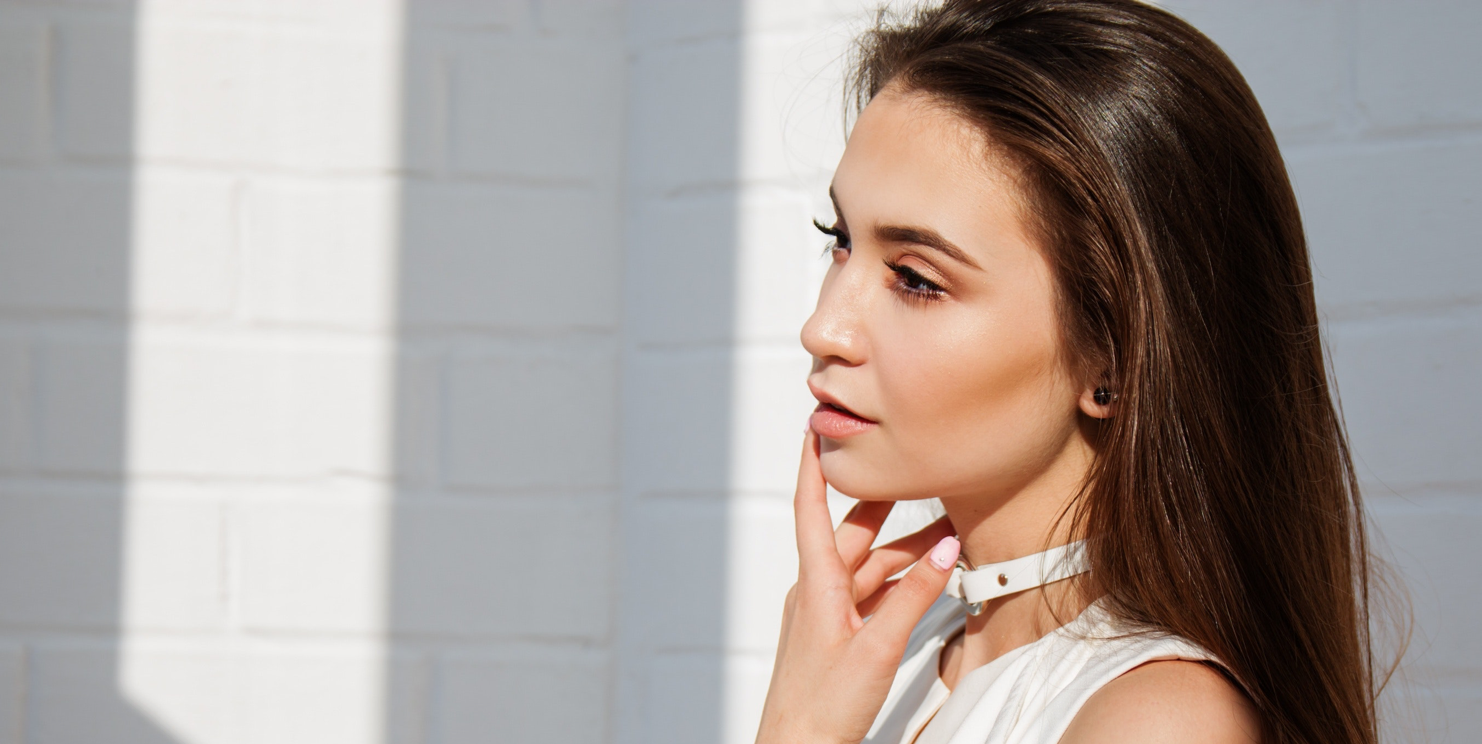
You are so cool! I don’t believe I’ve read anything like this
before. So wonderful to find another person with unique thoughts on this topic.
Seriously.. many thanks for starting this up. This website is something that is needed on the web, someone with a bit of originality!
Perfect very good explanation…..?
V nice
hi id like to know . if th effects of both of these treatments actually does wear off? and if so, will i be worse off then before?
also i read one review, a very negative one , which said the lady fat had been dissolved in her face
as the hifu had practically melted it
i mean god, is this possible? as in a consultation i was told that it can be used to melt fat away and for tightening
but how does it know when not to melt some fat away?
i rang the clinic im planning on using and they gave me a very unexpected answer.
like i was expecting them to say we dont use such a high intensity or it doesnt work that way
but the clinician said to me we dont go over the fat pads.
which has left me more unsure
as there are fat pads all over the face .any advice or knowledge on this please
thankyou
Hi Elizabeth, our content is for information purpose only, we recommend speaking to the therapist directly at one of our selected salons to have customized feedback:
https://lookdiary.com.hk/list_treatment?title=hifu&min_price=0&max_price=1050&area=